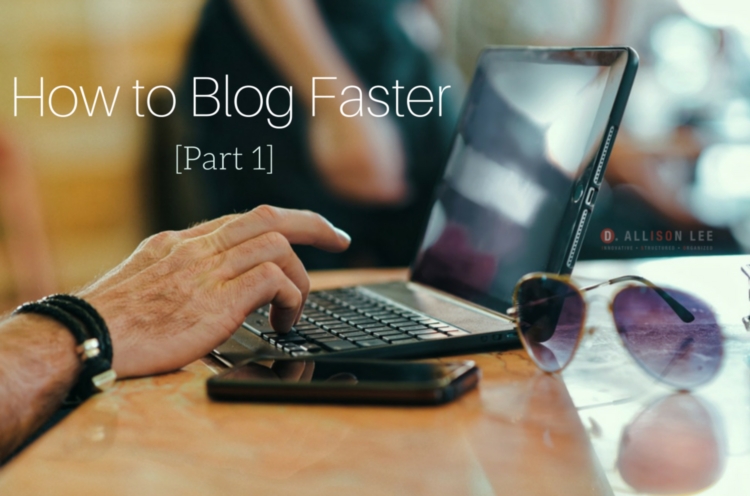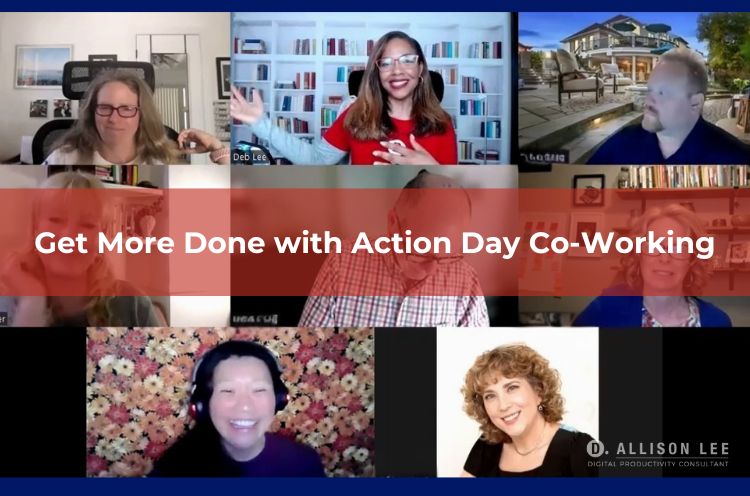Being productive when you don’t feel like it? Yeah, that’s tricky. You're not always going…

Blog Faster: What to Do Before You Start Writing Your Blog Post [Part 1]
You have probably come to realize that blogging is not a quick task. It can often be a time consuming and lengthy process. But, the good news is that there are a few things you can do to speed up the process and blog faster. Armed with specific strategies, you can spend less time on production and focus some time on promoting your content.
There are a lot of blogging tips and processes to help you be more efficient when writing your blog posts, and I’ll be sharing them in four parts. In the end, here’s what you’ll learn:
1. What to do before you start writing your post (This post!)
2. How to speed up your research
3. How to keep graphics from sucking your writing time
4. How to save time when writing (featuring the one tool every blogger should use)
So, let’s jump right in!
What to do Before You Start Writing Your Blog Post
Before you start writing, you need to plan. Does that mean that you can’t capture ideas as they come to you? Of course, you can. But, you should have a plan to funnel all those juicy ideas into a fully developed post.
So, before you begin putting pen to paper or fingers to keyboard, you should first create a plan — not just for your individual posts, but also for your blogging process. Come up goals that you’d like to achieve, one of which should include being consistent with publishing your content.
Questions You Should Ask Yourself
- What specific steps will you need to take before publishing each blog post?
- Your posting schedule: Once per week? Several times per week?
- What’s your writing style? Will you write every day? Is your plan to write and schedule several posts at once? Will you write the post on the day is scheduled to be published or a day in advance?
- How you will capture blog ideas and resources? Where will your store your running list of ideas of spontaneous blog topics?
- What type of editorial calendar you will use: digital, paper-based, or plugin?
- Will you have a recurring feature or topic? (I do this with my Fact Friday posts). Will you write about themed or seasonal topics? Will you create a blog series? (like this series on “Blogging Faster”).
- How long with your posts be? Epic with 1500 words or more? Short and sweet with 350-500 words? Or, somewhere in between? This post falls in that last category with 1,063 words.
Basic Things You Can do Before Writing Individual Posts
- Research keywords. Make a note of possible topics that might be generated from those keywords.
- Pick a single focus. From your list of possible topics, highlight single ideas. (Single ideas make focused blog posts!)
- Collect data. Research each idea, making notes of URLs or links that you come across that are helpful to you.
- Create compelling blog post titles. As you study each idea you’ve highlighted, create titles for your blog posts.
- Fill up your schedule. Enter them on your Editorial Calendar or paper calendar or a digital calendar.
- Start writing! … and use a template to help you get your blog skeleton or outline ready.
Blog Faster: What to Do Before You Start Writing Your Blog Post #blogging #productivity #timemanagement #bloggingtips Share on X
But, that’s not all. Yes, there’s more to consider, but once you get a process in place (and start using it regularly), you’ll have a more streamlined writing process. Don’t stop reading now! Here’s are some must-use tips you’ll need:
Find the Ideal Length For Your Blog Posts
Something to keep in mind is that the ideal length of your blog post will vary based on your audience and topic. You might want to include epic blog posts (1,500+ words), long posts (800-1,000 words), and short posts (350-500 words) to mix things up a bit.
When you check your analytics, you’ll see which post length your readers prefer. You never know, they might like them all which means you would need to vary the length of your posts regularly. Not a bad idea since you’ll likely get (and hopefully, keep) the attention of a variety of readers.
Make Your Posts Easier to Read or Scan
If you want to make it easier for readers to read your posts, use sub-headings and bullet points. As it turns out, many people actually don’t read posts, they scan them. And, when there’s too much text, it’s hard to scan the page.
Instead of continuing to read, they often opt to leave the page or website altogether. Yikes!
Why not make it easier for you blog readers to get the main points of your content by breaking up the text with headings and bullets? It’s simple enough to do and can even help you as you write.
Write your Introduction, Conclusion, and Call-to-Action First
Write the core pieces of your content first, like the:
- Introduction
- Conclusion
- Calls to Action
Doing this will help you to keep a laser focus on your topic and main themes. Then, go back and fill in the details for each section. By the way, using a blog post template with these sections included can help you get started and save you time.
The more you stay on topic, the less you’ll have to edit. #blogging #productivity #timemanagment #bloggingtips Share on X
Keep Your Post Focused
The more you stay on topic, the less you’ll have to edit. When you start going off on tangents, this will not only take up your writing time, but it might also confuse the reader.
When you notice these tangents, add them to your blog ideas file or Evernote notebook. That way, you have a place to capture future blog post ideas and you can get back to writing your current post.
Limit Distractions and Use a Timer
It’s also easy for you to physically go off on tangents and focus on bright, shiny things that pop up in front of you. So, turn off all notifications during your blogging time.
That means you will need to:
- Log off from Facebook, Instagram, and all social media (Note: the RescueTime app can help)
- Turn on Do Not Disturb (DND) on your smartphone or put your phone in another room
- Keep only your writing tab open
And, set a timer for a reasonable amount of time for you to write. Try a short amount of time like 25 minutes (check out The Pomodoro Technique — affiliate link) … or, a longer working block, like 45-60 minutes.
Up Next
Next in the “Blog Faster” series is: How to Speed Up Your Research. Remember, research isn’t writing, but it is a very important part of the process.
Have any questions, comments, or tips of your own? Share them in the comments below. <– Pssst! This is a call to action. What actions do you want YOUR readers to take?




You are my expert… so I have a question. Am I allowed to embed a link to someone else’s youtube video in my blog post?
Hi, Seana – Yes, you can embed someone else’s video in your blog post as long as long as the creator of the video allows it. Most people like when you use their video content. You won’t have to worry as much about attribution (like you would with images) because sites like YouTube and Vimeo generate a link back to that person’s account. Be cautious with TV shows and movies, though.
I covered a lot of this in my talk on How to Write Blog Posts that Get Results, but only the parts about individual posts. Your steps on what to think about before you even start a blog are super useful!
Thanks for the kind words, Janet. =) There’s nothing worse than doing a lot of work and then having to start all over again because there wasn’t a plan (or it wasn’t well thought out). I’ve learned the hard way. 😉
Great list Deb, I am looking forward to reading the series. I was on track a while back and then I fell off the wagon, but this post has made me rethink about how I schedule writing my posts, so thank you.
You’re welcome. =) I’m glad you’re feeling inspired again. Sometimes making one simple change can make all the difference. Feel free to stop by and share how your new schedule works. =)
So, Winnie-the-Pooh was right? Organizing your blogging strategy is what you do before you blog, so that when you blog, it is not all mixed up? Great ideas, Deb!
Yep, Winnie-the-Pooh’s advice does apply to blogging. 😉 Thanks for stopping by, Hazel. =)
I like how you modeled the format that you described using bold headers and bullet points. It really does help the reader (me.) There is SO much to read. I find that if it doesn’t look good visually or it’s TOO dense, I’m immediately turned off to exploring further. So I appreciate when the writer helps me focus on what’s important.
I’ve developed a process for blogging which works well. Many of the points you make are part of my routine. The one thing I haven’t “officially” done is check the analytics to see which length my readers prefer. But based on an what I’ve observed, they seem to prefer shorter to longer. And that’s a good thing, because those are my preferred posts to write.
Hi Linda – The headers and bullet points are really needed with longer posts. Otherwise, you might end up losing the reader because the text becomes overwhelming. The headers and bullets help me, too, as the writer since they are the building blocks of my outline.
You make a great point about knowing your audience and watching for the types of content they like. I suspect that when you do look at your stats, they will probably back up you’ve been observing.
Always great to hear from you, Linda. =)